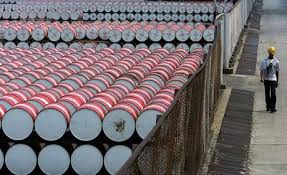 WTI and Brent futures were deeper in the red during early trade in Europe today, extending the recent slump to a sixth out of seven sessions. A bearish EIA report on Wednesday weighed on crude contracts, signaling lackluster consumer demand amid growing global supply.
WTI and Brent futures were deeper in the red during early trade in Europe today, extending the recent slump to a sixth out of seven sessions. A bearish EIA report on Wednesday weighed on crude contracts, signaling lackluster consumer demand amid growing global supply.
WTI futures for October delivery on the New York Mercantile Exchange traded at $91.47 per barrel at 7:01 GMT today, down 0.22% for the day. Prices ranged from $91.41 to $91.91 per barrel. The contract has dropped 1.16% yesterday, reaching a 16-month low at $91.22.
Meanwhile on the ICE in London, October Brent stood at $97.80 per barrel, down 0.24%, daily prices between $97.75 and $98.26 per barrel. October Brent’s premium to its US counterpart narrowed to $6.33. The European contract dropped 1.13% on Wednesday, to log a 17-month bottom at $97.60.
“I would expect to see the market remain under pressure,” Dominick Chirichella, analyst at the Energy Management Institute, said for The Wall Street Journal. “Barring a hurricane or any unforeseen [geopolitical] event, I think well remain in a modest downtrend here.”
Bearish US figures weighed on crude prices yesterday, extending the losing streak to a fifth session out of six. The EIA report, which covers the week through September 5, revealed crude inventories dropped 1 million barrels, largely meeting expectations of 1.1m-1.5m draw. The decrease extends the series of declining US stocks to an 11th out of 12 weeks.
Production of crude logged a minor drop to 8.6 million barrels per day, up 11% on an annual basis. Net imports last week were 7.2m, down 9% on an annual basis, outlining the shift towards domestic production, in light of booming shale production in the US.
“Theres too much light, sweet crude out there,” Michael Wittner, head of global oil research at Société Générale, said for The Wall Street Journal. “Also, demand has been weak.”
Gasoline stocks surprisingly added 2.4m barrels, compared with expectations of no change or slight decrease, signaling the US is oversupplied with the fuel, pressuring crude lower. Meanwhile, distillates, a category which includes diesel and heating fuel, were up almost 4.1m barrels, compared with forecasts of a 0.6m-1m gain.
Refineries bumped up production, EIA logging a weekly refinery utilization rate of 93.9%, 1.5% up on annual basis and almost 10% more than two years ago. Gasoline production, however, was actually some 5% lower than a week ago at ~9m barrels daily, while distillates output averaged 5.1m, little changed from a week ago.
“It’s the potential for oversupply and the economics not really supporting the demand picture” that’s driving prices lower, Jonathan Barratt, the chief investment officer at Ayers Alliance Securities in Sydney, said for Bloomberg. “The production frontier is shifting and geopolitical risk is waning.”
OPEC, Middle East
The Organization of Petroleum Exporting Countries (OPEC) revised downwards its projection of demand for its crude for next year. The organization now expects an average of 29.2m barrels per day to be marketed by its member countries, 200 000 less than it foresaw a month ago.
Meanwhile, Saudi Arabia, by far the biggest producer in OPEC and the world’s largest crude exporter with daily shipments of some 7m barrels, said domestic production was down 400 000 barrels per day in August, spurring speculation that an imminent deeper cutback in production is due, as to support faltering crude prices.
OPECs forecast revision “is the clearest acknowledgment that the current requirement for OPEC crude is far less than they are currently supplying to the market,” Abhishek Deshpande, analyst at Natixis, said for the Financial Times. We would hence expect Opec to reduce oil output in coming months and a large chunk of this could easily come from Saudi Arabia.”
The revision also outlines a wider, global trend of supply outgrowing demand. Booming shale production and the return of Libyan and more Iraqi crude to the market, in addition to a glut in the Atlantic basin, paint a bearish outlook for crude prices.
“OPEC cutting back demand is telling a story of oversupply, oversupply, oversupply and the economics of demand is not enough to raise prices,” Barratt said for Reuters. “Well see $85 a barrel sooner rather than later – in the next one or two months,” Barratt said, referring to U.S. oil.
Technical support and resistance levels
According to Binary Tribune’s daily analysis for Monday, West Texas Intermediate October futures’ central pivot point is at $91.97. In case the contract breaches the first resistance level at $92.73, it will probably continue up to test $93.78. Should the second key resistance be broken, the US benchmark will most likely attempt to advance to $94.54.
If the contract manages to breach the first key support at $90.92, it will probably continue to drop and test $90.16. With this second key support broken, movement to the downside will probably continue to $89.11.
Meanwhile, October Brent’s central pivot point is projected at $98.37. The contract will see its first resistance level at $99.14. If breached, it will probably rise and test $100.24. In case the second key resistance is broken, the European crude benchmark will probably attempt to advance to $101.01.
If Brent manages to penetrate the first key support at $97.27, it will likely continue down to test $96.50. With the second support broken, downside movement may extend to $95.40 per barrel.





